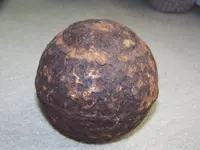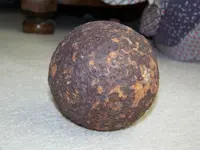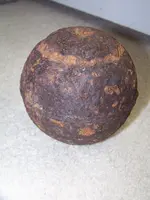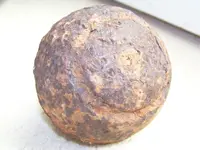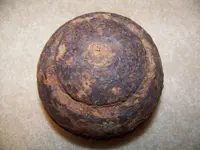Davcw asked me to comment.
That is an "intriguing" iron ball... because some of its characteristics indicate it is a hollow exploding cannonball, but other characteristics indicate it isn't a cannonball.
For the moment, instead of listing all the Yes and No characteristics, I'll deal with the main one which indicates it is not a cannonball. In the photos, it appears to have a 3/8"-wide groove encircling its top, about 3/4" down from what might be a fuze-hole. In my 40 years of closely examining genuine cannonballs I've never seen such a groove on a cannonball, and nothing like it appears in any of the various books showing cannonballs which got used in America.
Other thoughts in response to the info you've provided:
1- The diameter-to-weight ratio you reported (6.9 pounds, 4.01"-diameter) proves the ball is hollow, not solid.
2- As the size-charts in the civil war era US (and Confederate) Ordnance Manual shows, no 9-Pounder caliber explosive cannonballs (Common-Shell or Case-Shot) were manufactured in the civil war era, nor for several decades prior to that.
3- As Ponz mentioned, the presence of a large ironcasting-mold seam projecting outward from the ball is an indication that it is not a cannonball. However, I've seen a very few crudely-cast Colonial Era cannonballs which have a small projecting seam. The size of the seam on your ball is "borderline"... meaning, I lean away from it being a cannonball, but I cannot absolutely exclude the possibility, based just on the seam. The groove around the ball's top is a much more important problem.
4- A helpful clue for identifying an iron ball as an artillery ball or a Civilian-usage ball is the location where it was found. We check to see whether or not a cannon which fired that specific size of ball was ever at that location. Where did you find that ball?
The ultimate test about your hollow ball is to carefully, SAFELY remove the rust-crust which fills the hole, to see whether or not there is any gunpowder inside it. Send me a T-Net Private Message telling me your phone number, so we can discuss how to get that done safely.
